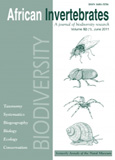О журнале
African Invertebrates is one of leading international peer-reviewed journals in the field of taxonomy, systematics, biogeography, biology, ecology, conservation and palaeontology of Afrotropical invertebrates, whether terrestrial, freshwater or marine. African Invertebrates is a recognised international vehicle for all aspects of invertebrate studies on the African continent and in surrounding waters, and has a more than one century-long history of excellence in broadcasting scientific achievements to researchers around the world. African Invertebrates is covered by ISI Science Citation Index (IF2009, 1.216), BIOSIS Previews, Zoological Record, Scopus and GeoRef. At present, the journal is published two times per year. Archival issues (1906-2007) are freely available through SABINET African Journal Archive.
Научная область
Vol. 51, Issue 1
Содержание
The United Nations declared 2010 to be the International Year of Biodiversity. It is one-year world-wide celebration of biological diversity and its importance for life on Earth. While biodiversity is frequently spoken about in the context of its conservation, no one would argue that protection....
Natalina sensu lato includes some of the largest carnivorous snails in the world and represents an important African radiation of the Gondwanan land snail family Rhytididae. It comprises the taxa Natalina, Afrorhytida and Capitina, all three of which we treat as full genera. We provide a....
Five new species of the endemic giant pill-millipede genus Zoosphaerium from Madagascar are described: Z. muscorum sp. n., Z. bambusoides sp. n., Z. tigrioculatum sp. n., Z. darthvaderi sp. n., and Z. heleios sp. n. The first three species fit into the Z. coquerelianum species-group, where Z.....
Twelve species of the Spartaeinae from Africa are considered. Previously unknown sexes are described for three species: Cyrba nigrimana Simon, 1900 (male); Meleon raharizonina Logunov & Azarkina, 2007 (female); and Meleon russata (Simon, 1900) (male). Three species, Cyrba lineata Wanless,....
Microstylum vespertilio Engel, 1932 is redescribed from the Northern Cape Province of South Africa and transferred to Daspletis Loew, 1858, a genus closely related to Microstylum Macquart, 1838, that now incorporates eight southern African species. Knowledge of the species is updated and a new....
The nymphal stages of the African mopane psyllid Retroacizzia mopani occur on Colophospermum mopane leaves, feeding on the phloem sap. The emergence of R. mopani coincides with the dry winter period in South Africa, when other trees are leafless. The nymphal stages secrete a scutcheon-like....
Two new species of the genus Tachydromia Meigen are described: T. freidbergi sp. n. (Ethiopia) and T. stuckenbergi sp. n. (Uganda). Re-descriptions of T. lilaniensis Smith, 1969 and T. petrabilis Smith, 1969, known from South Africa and Lesotho, are given. A key to Afrotropical Tachydromia is....
The "colonial explorer" image was about exploration and conquering exotic lands. Specimens of everything that was encountered were collected and often later donated or sold to museums. This approach became unpopular because it encouraged overcollecting of natural areas to make money....




